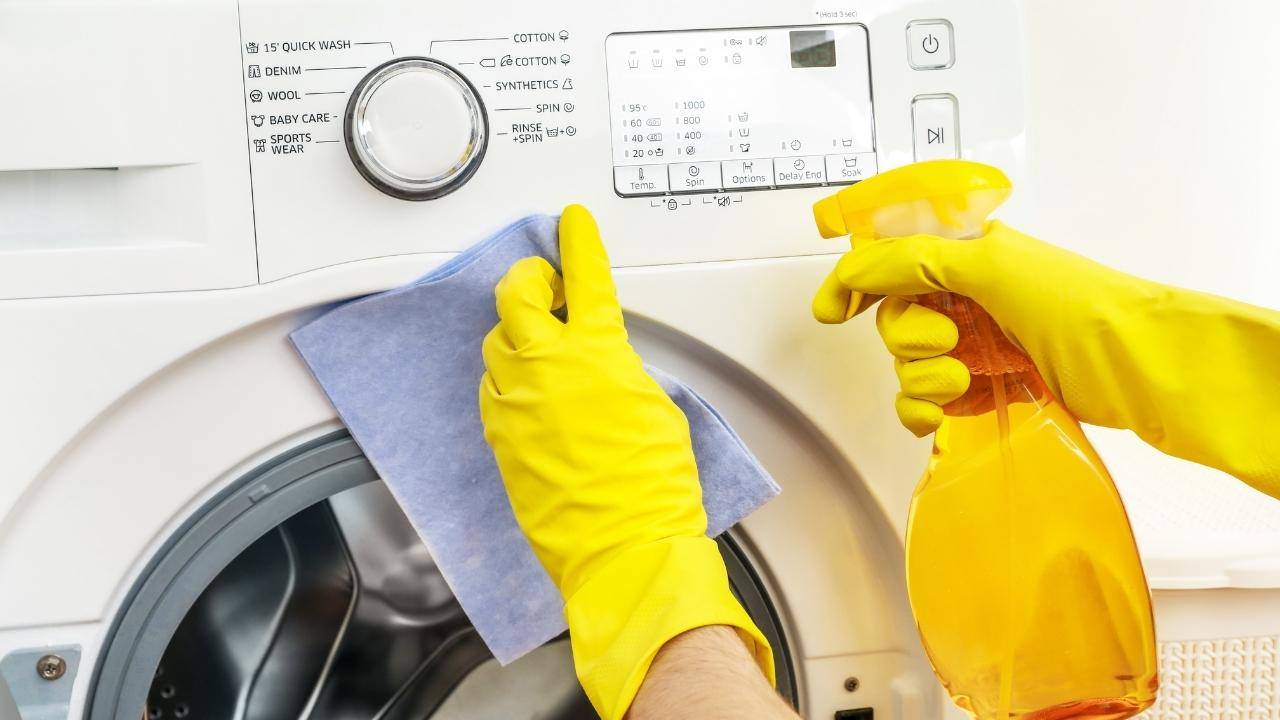The clothes that came out of my washing machine were crisp and clean, but over time my machine started smelling like an old cellar.
I didn’t have to Google it to realize that it was the water that remains after each load in combination with sticky fabric softener residue that was causing the odor.
You could even see those build-ups at the far end of the detergent tray.
I was told to pour a ¼ cup of bleach into the tray and run the hottest and longest cycle, so I did that. It might’ve destroyed the mold and mildew, but the odor remained.
Since I never use harsh chemicals and synthetic deodorants I turned to nature.
After all, it’s laundry we’re talking about. The last thing I needed was to get a rash from a chemical washing machine cleaner.
After some experimenting, trial, and error, I found the perfect way to keep my washing machine looking and smelling nice every time.
In this post, I’ll show you how to make your own 100% natural DIY washing machine cleaner.
3 Best DIY Washing Machine Cleaner Recipes
Here are the three recipes for homemade cleaners for washing machines that I’ve used with great success.
Vinegar + Baking Soda + Essential Oil (For Top- and Front-Loaders)
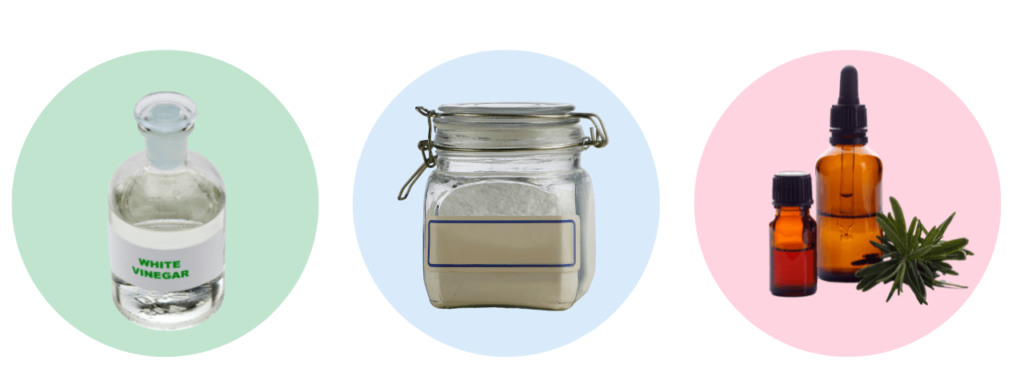
| Ingredients | Quantity | ROLE |
|---|---|---|
| White vinegar | 2 to 4 cups | Breaks down mineral deposits |
| Baking soda | ½ to 1 cup | Acts as a gentle scrub |
| Essential oils | 10 drops | Provides a fresh scent and mild disinfection |
Revitalize Your Machine in Easy Steps
1. Begin with Baking Soda
Empty your washing machine. Add 2 cups of baking soda. This powder gently scrubs the inside, targeting stale odors from soap and softener residues.
Start a long, hot cycle. Let the baking soda work its magic.
2. Introduce Vinegar and Essential Oils
Next, mix 2 cups of plain white vinegar with 10 drops of essential oils. Lavender or tea tree are excellent choices. Add this to the detergent compartment.
Another hot cycle will now commence. The vinegar effectively breaks down any lingering mineral deposits and moldy areas.
3. Final Touches
After both cycles, wipe the drum and agitator. Use a cotton cloth soaked in vinegar for this.
For stubborn stains, create a paste using baking soda and water. Apply it with a non-scratch sponge.
If using a front-load washer, focus on the rubber gasket. Wipe it down with a vinegar-soaked cloth and a few drops of essential oil.
Understanding the Science
Baking soda and vinegar are opposites on the pH scale. This contrast is key to their cleaning power. Baking soda, a base, dissolves organic matter and gently polishes surfaces. Vinegar, an acid, targets hard water minerals. Together, they lift dirt effectively, thanks to the CO2 released when they interact.
Mixing Tips
Combine these cleaners wisely. Do not mix them in equal amounts. Keep the solution either acidic or basic to maintain its effectiveness.
The Eco-Friendly Choice
This DIY method is not just effective; it’s also kinder to our planet. By choosing natural ingredients over harsh chemicals, you’re making an environmentally conscious choice. Plus, it’s a safer option for homes with allergies.
Vinegar + Essential Oil (For Weekly Cleaning)
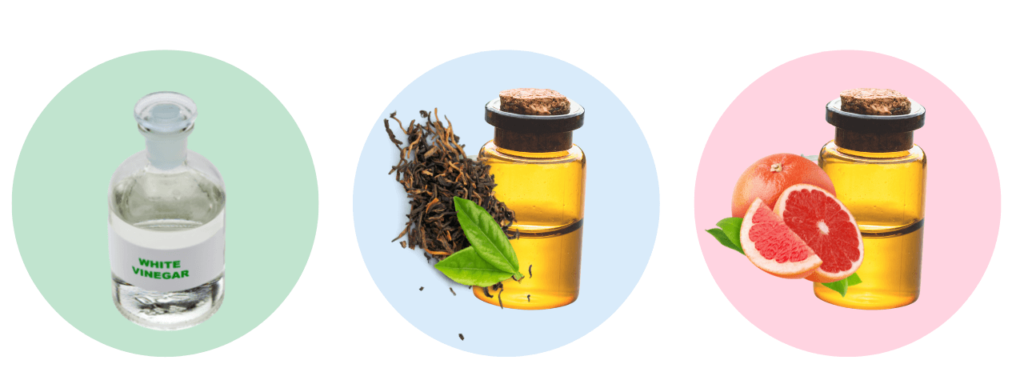
| Ingredients | Quantity | ROLE |
|---|---|---|
| White vinegar | ¾ cup | Natural disinfectant |
| Tea tree oil | 10 drops | Known for its antibacterial properties |
| Grapefruit oil | 5 drops | Adds a refreshing scent |
Easy Weekly Cleaning Steps
1. Create Your Cleaning Mix
Start by combining all ingredients in a spray bottle. Before each use, give the bottle a good shake. This ensures the ingredients are well mixed.
2. Apply with Care
Spray the solution onto the seal, drum, door, or lid of your washing machine. The type you have dictates where to apply. Let the mixture sit for a few minutes. This allows the ingredients to work their magic.
3. Wipe Down
After a few minutes, wipe all treated areas with a clean cloth. Regular use makes future cleanings easier and more effective.
I use this cleaner after every laundry load. This practice makes it much easier to maintain a clean machine.
How This Cleaner Works
Vinegar’s Role
White vinegar, a diluted form of acetic acid, acts as a disinfectant. It’s particularly effective against some bacteria and fungi. Interestingly, its disinfecting power increases with heat. That’s why it’s so efficient in hot laundry cycles.
The Power of Essential Oils
Essential oils are made of volatile compounds that evaporate easily. These oils, naturally found in plants, often contain antibacterial elements like aldehydes, phenolics, and terpenes. These compounds make the oils effective against a range of bacteria, fungi, and even viruses.
Strongest Antibacterial Oils
Some of the most potent antibacterial essential oils include tea tree, lemongrass, oregano, black cumin, and peppermint.
Dish Soap + Washing Soda + Vinegar + Tea Tree Oil (For Deep Cleaning)

| Ingredients | Quantity | ROLE |
|---|---|---|
| Dish soap | ½ teaspoon | Cuts through grease |
| Washing soda | 4 tablespoons | A powerful stain remover |
| White vinegar | 1 cup | Acts as a natural disinfectant |
| Tea tree oil | 20 drops | Adds antibacterial properties |
Deep Cleaning Steps
1. Start with the Detergent Tray
Begin by removing your machine’s detergent tray. Soak it in a mixture of hot water and eco-friendly dish soap. I find this soap works wonders.
Use an old toothbrush to scrub away any buildup. Once clean, return it to the machine.
2. Washing Soda Cycle
Next, pour washing soda directly into the drum. Run your machine on its hottest setting. This step is crucial for tackling tough stains and grease.
3. Vinegar and Essential Oil Finish
After the cycle, add vinegar and tea tree oil to the liquid dispenser. Run another hot cycle. This combination enhances cleaning and leaves a fresh scent.
4. Final Touches
Once the cycle is complete, thoroughly wipe all areas. Don’t forget to leave the door or lid open to air-dry. This step is essential before you do any laundry.
Understanding the Cleaning Agents
Washing Soda’s Role
Also known as “soda ash,” washing soda comes from burned plant ashes. Its high alkalinity makes it an excellent solvent, perfect for removing greasy buildup and soap scum. It even unclogs drains. However, handle it with gloves to protect your skin.
Deep Cleaning Benefits
Regular deep cleaning prevents mold growth in your machine. It ensures every laundry load comes out fresh and clean.
A Little Precaution Before Getting Started
Before embarking on any cleaning endeavor, it’s wise to consult your washing machine’s owner’s manual or the manufacturer’s website. This ensures the longevity and proper care of your appliance.
While generally safe, using natural cleaners like white vinegar, baking soda, and citric acid calls for caution. Specifically, go easy when scrubbing rubber parts like seals or gaskets. These components have protective coatings that can be sensitive to abrasive cleaning.
Many recommend bleach for cleaning washing machines. However, I’ve discovered that it can be too harsh for such use. More importantly, vinegar proves superior in banishing odors.

Vinegar, a natural cleaning marvel, works wonders as a disinfectant. When paired with baking or washing soda, its efficacy is enhanced. This combination excels at removing stubborn, gooey residues and preventing mold growth.
Lastly, essential oils can be a delightful addition to your cleaning regimen. Used judiciously, they are safe for all types of washing machines. Not only do they kill germs, but they also impart a lasting, pleasant aroma, eliminating the need for synthetic fragrances.
By following these guidelines, you can maintain a clean and fresh-smelling washing machine using safe and natural methods.
How to Clean a Top-Loading Washing Machine
You can prevent the buildup of detergent in your washing machine by running your homemade washing machine cleaner through it two or three times a year.
If you have hard water, the minerals build up faster on wet surfaces and joints. In this case, you should clean the washing machine every three months to remove the buildup from the inside.
To clean the top loader this is what you should do:
1. Run Vinegar Through the Washing Machine
Select the largest load size and the hottest water temperature setting that your washing machine supports.
As the washing machine fills with water, add 4 cups of white vinegar and let the machine fill up with water.
When the washing machine is completely full, wait for the load to start to run and pause the machine. Let the water and vinegar sit for an hour. This way vinegar has time to break down the detergent and mineral buildup on the walls of the machine.
2. Clean the Exterior
While you’re waiting, you can clean the exterior. For this, you’ll need a couple of old rags. Dampen a cloth with a little vinegar or use your natural house cleaner.
For the best results, I like to add some diluted vinegar to a spray bottle and spray the outside of the machine before wiping it clean.
I have to deal with water which is pretty hard where I live. That means that I generally have to wipe my bathroom surfaces more often because every drop or splash results in white mineral buildup if left unattended.
I discovered that a vinegar spray bottle is my best eco-friendly ally in dealing with those stains.
3. Scrub out the Detergent Dispenser
The load space will get the most attention, but you shouldn’t overlook the drawer that holds the detergent and fabric softener.
While you’re waiting for the vinegar to work into the deposits, remove the tray and use an old toothbrush to scrub out the detergent residue from inside.
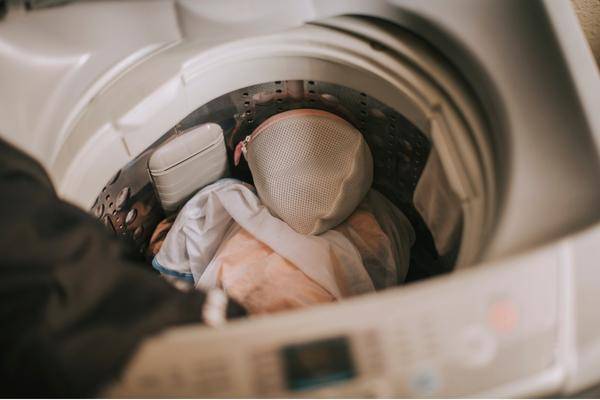
4. Restart the Washing Machine
After the vinegar has sat for an hour, restart your washing machine and let it run for a full cycle. Once it drains, you’re ready for the baking soda stage.
5. Add Your Favorite Essential Oil
This step is fully optional, and it won’t impact the success of the cleaning. It’ll make the scent much more pleasurable, but I’ve learned that certain oils are better for fighting mold and mildew.
Have you ever opened the washing machine lid and smelled the dampness and mold?
Namely, essential oils of oregano, thyme, clove, lavender, thuya, and clary sage have all antibacterial and antifungal properties. This makes them a great choice for a natural antibacterial washing machine cleaner.
6. Run One Cycle with Baking Soda
After you’ve run one cycle with vinegar, you need to run a second one with baking soda and essential oils.
Pour 1 cup of baking soda and add 3 drops of essential oils into the drum of the machine.
Choose the largest and hottest water cycle you can, turn the washing machine on again, and let it run completely without pausing.
7. Air-Dry the Interior
Let the water drain completely and leave the lid open for the interior to dry out. In fact, you should leave the lid open whenever possible, as it’ll prevent the buildup of odors.
After each washing cycle, there’s water in pipes and drains that needs to dry out. If you close the lid, the hot and moist environment can easily become a breeding ground for mold and mildew.
However, if you have pets or small children, make sure to wipe the interior of the machine dry before you close the lid.
How to Clean a Front-Loading Washing Machine
Front-loading washing machines are designed differently, which makes their cleaning a bit more challenging, as there are more steps to it.
But, as with top-loading machines, you should repeat the cleaning two or three times a year, or every couple of months if you have hard water.
So let’s begin.
1. Spray the Interior with Vinegar
Using your spray bottle of vinegar, thoroughly spray the interior of the front-loading washing machine. As with top-loaders, I use a white vinegar solution and let it sit while I wipe the door and the rubber gasket.
2. Clean the Washing Machine Door
Use the spray bottle to spray the door and the gasket with more vinegar. Make sure you soak them well. Now, use an old rag to wipe away the mold, mildew, and soap scum that have built up.
Make sure you get the buildup around the plastic window part. If you have hard water where you live, as I do, you’ll probably have to use something stronger to make that window clean and shiny again.
I recommend using this baking soda and vinegar natural cleaner you can easily make. Works great for clogged drains, too!
3. Scrub the Rubber Gasket
The rubber seal or gasket will probably be the dirtiest part of your washing machine. Water and moisture tend to collect there, and add a long-missing sock and there you have a perfect hotspot for mold.
I use a soft-bristle brush and the baking soda and vinegar cleaner solution to scrub the area clean.
Once you do this, go back and wipe the inside of the metal drum as well.
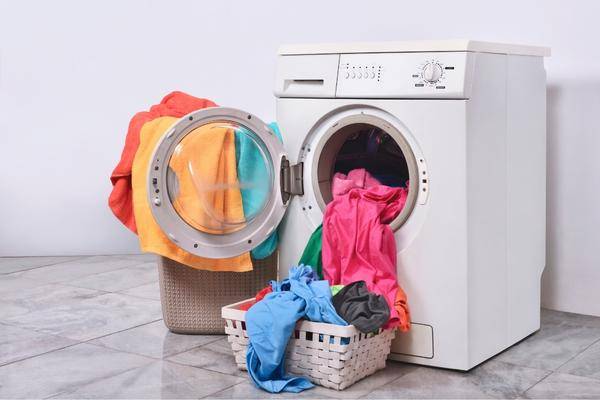
4. Don’t Forget the Tray
This is a critical step that often gets overlooked. Before you run a vinegar cycle, make sure to scrub the drawer where you put the detergent, bleach, or fabric softener.
While some machines have it differently, in most cases you can remove the tray by lifting it or depressing a lever of some sort.
As with top-loading machines, you can use an old toothbrush to scrub the drawer with vinegar.
5. Ready for a Vinegar Wash
Close the washing machine door and choose the largest and hottest cycle setting — this kinda becomes a theme here.
Now you want to pour not 1 but 2 cups of white vinegar directly into the detergent dispenser. Wait for the load to finish running.
6. Another Round of Baking Soda
Once the water from the vinegar cycle has drained, open the door of the machine and add ½ cup of baking soda and a few drops of your preferred essential oil.
Select the same setting and run another cycle.
7. Wipe the Exterior While Waiting
While you’re waiting, spray the outside of your washing machine with vinegar and wipe it down with an old rag.
8. Air-dry the Interior or Wipe it Down
Once the second cycle is through, open the root and pipe down the interior with a dry cloth, and leave the door ajar to let it dry. As with top-loading washing machines, you should leave the door open whenever possible to let the supply and drain pipes dry as well.
If you have pets, make sure to check the drum every time before closing. For some reason, cats love to sneak inside to sleep.
How to Tackle Smell Problems with a DIY Washing Machine Cleaner
Washing machines, often the largest appliances in our homes, might not get the cleaning attention they need. It’s only when our laundry starts to smell odd that we take action. Gross, but true.
It’s unsettling to think that our go-to appliance for cleanliness can become a germ haven. Despite the detergents, fabric softeners, and hot water, these machines don’t self-clean.
Sometimes, even if you diligently repeat the cleaning processes I’ve described, stubborn odors linger. But let’s tackle this head-on. The key to a fresh washing machine is focusing on water-collecting areas.

For top-loaders, the lid is crucial; for front-loaders, it’s the door. Tackle these with a toothbrush and soft-bristle nylon brush, targeting the tricky spots.
Regular maintenance is also key. I always keep a microfiber cloth handy to wipe down the door after each load. This simple habit helps prevent odor buildup.
When faced with a particularly stubborn smell, I once resorted to True Fresh tablets. These proved to be effective.
Affresh, a blend of oxygen-based bleach and sodium carbonate, is another excellent option. Select the tub clean or a normal cycle, add an Affresh tablet, and run the machine empty.
For laundry items like towels and gym clothes, consider the sanitize cycle. It uses the hottest water and an extended wash to effectively kill bacteria.
How Often Should You Clean Your Washing Machine?
The frequency of cleaning your washing machine depends on how often you use it and what you wash, but a general guideline is to clean it once a month.
Regular use can lead to the buildup of detergents, fabric softener, dirt, and grime, which can cause odors and affect the machine’s efficiency.
If you wash items that are particularly dirty or oily, or if you often use cold water cycles (which are less effective at dissolving residues), you might need to clean your machine more frequently. Always refer to your machine’s manual for specific recommendations.
Regular cleaning helps maintain the machine’s performance and extends its lifespan.
How to Keep Your Washing Machine Cleaner for Longer
To keep your washing machine cleaner for longer, start by using the right amount of detergent. Overuse can lead to residue buildup. Additionally, opt for high-efficiency detergents if you have an HE machine. They are specifically designed to create fewer suds and leave less residue.
After each use, leave the washing machine door or lid open. This allows air circulation, preventing the growth of mold and mildew. Moreover, regularly remove and clean the detergent drawer and any removable dispensers. Residual detergent and fabric softener can create a breeding ground for bacteria.
For those in hard water areas, consider using a water softener. Hard water can lead to mineral deposits in your machine, affecting its efficiency. Furthermore, once a month, run an empty hot water cycle with a washing machine cleaner or white vinegar. This helps dissolve any lingering residues.
Also, check and clean the machine’s filter regularly, as trapped debris can cause odors and affect performance. Finally, wipe down the exterior and control panel with a damp cloth. This prevents dust accumulation and keeps your machine looking new.
By following these simple steps, you can extend the life of your washing machine and ensure it runs efficiently, keeping your clothes clean and fresh.
Frequently Asked Questions (FAQ)
You can use white vinegar, baking soda, washing soda, and essential oils.
Yes, vinegar can damage rubber seals and hoses in some machines, so you should always consult the owner’s manual before using vinegar as a cleaner.
No, baking soda doesn’t ruin your washing machine. Still, make sure you use it in moderate amounts, as given in the natural washing machine cleaner recipes on this page.
Yes, distilled vinegar is the same as white vinegar.
Dip a cotton cloth into vinegar and wipe the washing machine seal to remove any mildew, hair, and residue. If it still hangs on, make a paste of baking soda and water and gently scrub away using a soft-bristle nylon brush.
For deep cleaning, you first need to remove the detergent tray and clean it with dishwashing soap. Put it back and pour 4 tablespoons of washing soda into the drum. Run a hot cycle, let it drain, and repeat the cycle but this time, pour 1 cup of white vinegar and 20 drops of essential oil into the dispenser tray. When the water drains, open the machine to dry out.
You can use white vinegar, baking or washing soda, and essential oils.
Yes, you can clean your washing machine with baking soda and vinegar at the same time. Just make sure not to mix them in equal parts because they neutralize each other, canceling out the benefits of vinegar’s low PH and baking soda’s high pH.
Final Words
By cleaning your washing machine regularly, you can eliminate moldy smells caused by the detergent and fabric softener buildup.
These buildups not only cause unpleasant odors but also shorten your washing machine’s life.
However, since it’s where you wash your clothes, I strongly advise against using chemical machine cleaners.
Instead, use a DIY washing machine cleaner that relies on the simple but powerful chemistry of natural ingredients like vinegar, baking soda, and your favorite essential oils.

